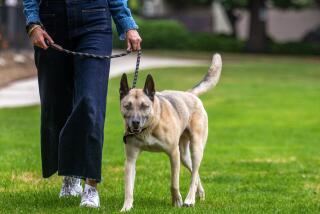How to Make Dog Behave as Man’s Best Friend
- Share via
Dog trainer Mark Katz advocates training a puppy as early as eight weeks of age.
“Simple, short lessons that teach him who is boss and some basic commands are excellent for him. It is far easier to teach good habits early than to have to break bad ones later on. An owner with complete control of his dog has accomplished the most important thing for his dog’s future.
“Behavioral problems are credited with being the biggest killer of dogs,” he says. “Of the more than 10 million destroyed in shelters each year, more than half of them were brought there because of unwanted behavior, according to a report from the American Humane Society.”
“If all owners did learn to control their animals, I might not have as much work,” adds Katz, who for 24 years has specialized in correcting undesirable behavior in dogs as old as 14.
“When I say control of a pet, that’s what is absolutely necessary. However, I love to watch a dog do his own thing, just what comes naturally. I’m not against him getting up on the couch or jumping up on someone in friendship. If his owner doesn’t mind these actions, then there is no need to stop him. However, that owner should be in control of him and capable of saying ‘No’ and being obeyed. Because, even the slightest unwanted and uncontrolled behavior will create an unwelcome nuisance,” he says.
While Katz works specifically with dogs who have behavioral problems such as being destructive, aggressive, chewing and stealing, he warns owners to be alert when an animal suddenly breaks from being a well-behaved dog by showing fears, excessive barking or maybe housebreaking problems. “It could be a health problem. Also, old age and the lack of hearing as well can cause the same symptoms. A return to basic training and changing feeding and watering for some seniors will help,” he says.
The trainer has strong feelings about raising and training a puppy properly.
He advises: “Be with the puppy as much as possible. Gently handle and cuddle him a lot, touching him all over, even his mouth, feet and ears. Expose him to people and to other animals. Give him plenty of rest but also take him places, into all types of situations. All of this will prevent him from becoming timid, shy and maybe eventually a fear biter.
“Test his personality and acceptance by placing him gently on his back to see just how much he will resist authority--I do this when I’m looking for a puppy. If he struggles or gets aggressive, hold him there firmly until he settles. They all will,” he says.
From the beginning, an owner should never accept any kind of aggression, because even the slightest can get out of control. But, “There is no need to ever strike an animal to train it,” he adds.
“Condition him to changes. Take his food bowl away while he is eating. If he growls, keep the food away for five minutes. Repeat it often until he stops growling when you take the food. See to it that all family members can take the bowl away with the same results. Adults should supervise the children. Apply this take-away to other things, such as his toys,” he advises.
“Set aside a time to put the puppy on a six-foot training leash to control his actions. If he begins to chew or misbehave, pull sharply on the lead and in a very corrective voice say ‘No,’ then replace that misbehavior with something you want him to chew or to do. Then praise him for doing it. On this leash he can begin to learn basic commands such as sit, stay, come and heel. In fact, exercise, work and playing with you all through his life will eliminate most problems.
“Remember, a puppy’s attention span is short-lived and training periods should be no more than 10 minutes at a time,” says Katz.
He and his wife, Dru, have a 1-year-old daughter, Sara. Both are from New York. They met in Baltimore where Dru, a veterinarian, has practiced for four years. She studied at the University of Pennsylvania and has practiced veterinary medicine since 1981, having spent time in the Army as a veterinarian with the rank of captain. She also spent time at the Philadelphia Zoo studying and raising primates.
Katz, 42, came to Baltimore 14 years ago to visit relatives, fell in love with the area and stayed. He began training dogs when he was 18 with Arthur Haggerty of New York, one of the country’s top trainers. “I can’t remember when I wasn’t interested in dogs and training,” says Katz.
The couple owns a mixed breed--once a stray--named Dog, a Corgi age 7, named Muffet, a horse named Jasper, two cats named Bubby and Spot and one African gray parrot named Wendell. They also raise canaries and have about 65 of them.
Katz says that an owner should be with his pets as much as possible. “I don’t like to see a puppy or dog confined in a crate except when it is necessary. When an owner cannot be with him, then I recommend it be put in a large dog crate, laundry room or such where it is safe.
“Just as an owner’s training and control brings a dog security, so does his den or crate when his owner cannot be with him to protect him from harm. If not overused, the dog will find security and remain calm in this safe area while the owner is away,” he says.
More to Read
Sign up for Essential California
The most important California stories and recommendations in your inbox every morning.
You may occasionally receive promotional content from the Los Angeles Times.













